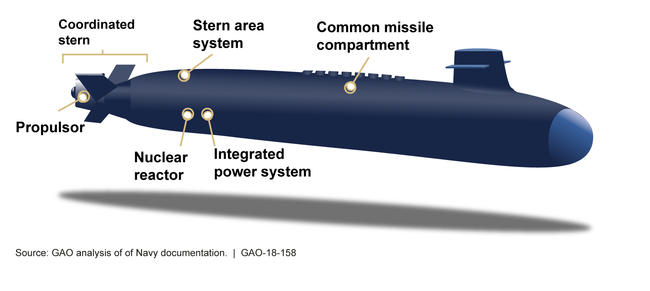Columbia Class Submarine: Immature Technologies Present Risks to Achieving Cost Schedule and Performance Goals
Fast Facts
Getting the first Columbia class submarine out on patrol by 2031 is essential to maintain an important U.S. nuclear capability. But doing so will be challenging and expensive—over $267 billion to develop, buy and operate 12 submarines.
We found that:
Several technologies critical to Columbia class performance need more development and testing; and,
Starting to design and build vessels before technologies are proven can lead to increased costs and schedule delays.
We had suggested that Congress consider requiring additional reporting on these technologies but, before this report issued, legislation passed that did so.
Columbia Class Submarine Critical Technologies

The graphic shows a submarine with the location of 6 critical technologies marked, including the reactor and missile compartment.
Highlights
What GAO Found
Additional development and testing are required to demonstrate the maturity of several Columbia class submarine technologies that are critical to performance, including the Integrated Power System, nuclear reactor, common missile compartment, and propulsor and related coordinated stern technologies (see figure). As a result, it is unknown at this point whether they will work as expected, be delayed, or cost more than planned. Any unexpected delays could postpone the deployment of the lead submarine past the 2031 deadline.
Further, the Navy underrepresented the program's technology risks in its 2015 Technology Readiness Assessment (TRA) when it did not identify these technologies as critical. Development of these technologies is key to meeting cost, schedule, and performance requirements. A reliable TRA serves as the basis for realistic discussions on how to mitigate risks as programs move forward from the early stages of technology development. Not identifying these technologies as critical means Congress may not have had the full picture of the technology risks and their potential effect on cost, schedule, and performance goals as increasing financial commitments were made. The Navy is not required to provide Congress with an update on the program's progress, including its technology development efforts, until fiscal year 2020—when $8.7 billion for lead ship construction will have already been authorized. Periodic reporting on technology development efforts in the interim could provide decision makers assurances about the remaining technical risks as the Navy asks for increasing levels of funding.
Columbia Class Submarine Critical Technologies

Consistent with GAO's identified best practices, the Navy intends to complete much of the submarine's overall design prior to starting construction to reduce the risk of cost and schedule growth. However, the Navy recently awarded a contract for detail design while critical technologies remain unproven—a practice not in line with best practices that has led to cost growth and schedule delays on other programs. Proceeding into detail design and construction with immature technologies can lead to design instability and cause construction delays. The Navy plans to accelerate construction of the lead submarine to compensate for an aggressive schedule, which may lead to future delays if the technologies are not fully mature before construction starts, planned for 2021.
Why GAO Did This Study
The Navy's Columbia class ballistic missile submarines will replace the 14 Ohio class that currently provide the sea-based leg of the U.S. nuclear triad, slated to begin retiring in 2027. The first Columbia must begin patrols in 2031 to prevent a gap in deterrent capabilities; the class will ultimately carry up to 70 percent of the nation's strategic nuclear capability. The program is a top Navy priority with an expected cost of $267 billion over its life cycle, including $128 billion to research, develop, and buy 12 submarines.
House Report 114-102 included a provision for GAO to examine the Columbia class program. Among other things, this review examines (1) the status of key Columbia class technologies; and (2) potential risks with the Navy's planned approach for design and construction.
GAO reviewed the Navy's technology readiness assessment, technology development plan, and the status of key prototyping efforts, and compared efforts with GAO's identified best practices for shipbuilding programs and technology readiness assessments. GAO also assessed the status of design maturity and the Navy's acquisition strategy and interviewed relevant officials.
Recommendations
GAO had suggested a matter for congressional consideration related to additional reporting on the Columbia class technologies, but removed it because of recent legislation that implements this requirement. Department of Defense comments on the draft were incorporated as appropriate in this report.
